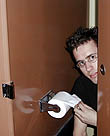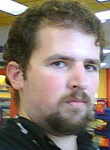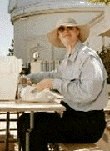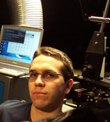|
|
This topic comprises 2 pages: 1 2
|
|
Author
|
Topic: (?)Theatre Sound Formats For Dummies(?)
|
|
|
|
|
|
|
|
|
|
|
|
|
|
|
Manny Knowles
"What are these things and WHY are they BLUE???"

Posts: 4247
From: Bloomington, IN, USA
Registered: Feb 2002
|
 posted 04-06-2003 01:05 AM
posted 04-06-2003 01:05 AM




i would argue that dts timecode is actually many barcodes in succession and not one long one.
---
as for a working definition of the formats (for dummies) i offer the following:
first we need to establish the terms "track" and "channel." [note: see also michael schaffer's definition below.]
a track is an actual individual recording. a cassette audio tape contains two tracks -- one for the left channel, the other for the right channel.
a channel is a path to a loudspeaker -- or to an array of loudspeakers. in the cassette tape example, the left channel is driven by the left track on the compact disc but the terms are not necessarily mutually exclusive, as we shall soon see.
mono -- one channel of sound. this can be driven by a single track or else by two identical tracks (see matrix decoding, below)
stereo -- anyone with normal hearing listens in stereo. most stereo applications employ only two channels of sound -- one for each ear. this usually works fine when listening takes place at close range but in large venues like a cinema, the stereo effect is greatly enhanced when the playback systtem employs more channels. cinema stereo typically utilizes channels designated by their location in the room. the speakers behind the screen are known as left, centre and right. the speakers above the seating area are for the surround channels. analog surround is mono. digital audio provides stereo surround channels (left surround, right surround). a newer system (see below) introduced a third surround channel (back surround).
the center (screen) channel is important because it almost always carries the dialogue track. isolating the dialogue and placing it in the centre of the screen improves intelligibility of the spoken words.
to understand how these multitrack systems work, we need to introduce two more terms -- "matrix" and "discrete."
matrix -- analog cinema stereo uses two tracks (known as Left-Total and Right-Total, or Lt and Rt). these two tracks are constantly analyzed during playback. sounds that are common to both tracks are isolated and redirected to the centre channel loudspeaker. so in the case of bilateral mono tracks (i.e. two identical tracks side-by-side) all of the information gets routed to the centre channel. sounds that are common to both tracks, but recorded out-of-phase, are also isolated and redirected to the surround channel (mono). the remaining sounds pass through to the left and right channels behind the screen. this illustrates why "track" and "channel" do not always mean the same thing.
discrete -- digital systems use discrete tracks. this means that for each channel, there is an actual track. in this case, the terms "track" and "channel" are interchangeable.
subwoofer -- a subwoofer is a speaker system that is designed to reproduce very low frequencies, which are typically felt moreso than they are heard. a device known as a "crossover" can strip away all low frequencies and redirect them to the subwoofer channel. not only does this ensure that those frequencies get properly utilized, it also protects the main loudspeakers which could sustain damage if exposed to these frequencies.
some systems also employ additional channels behind the screen....
left-extra appears between centre and left channels
right-extra appears between centre and right channels
why the extra channels? there are two good reasons. larger screens really benefit from having these channels. first, they fill in what would otherwise be two gaping "holes" between centre and the two outer channels (left and right). second, they give mixers the option to separate the music track from the effects track, the idea being that the reduced "competition" between sounds coming out of any given channel will improve intelligibility.
benefits of digital audio
-- discrete channnels eliminate matrix-decoding errors. crystal clear audio over long-term (versus gradual degradation of analog tracks).
-- improved dynamic range means that digital sound can be quieter than an analog track (which will always contain some "noise") and digital tracks can get louder than analog (the analog waveforms must fit within a space that imposes this limit).
-- improved frequency response (lower lows, higher highs)
digital sound formats in use today --
dts -- this is a dual system, which means that there are two components. the first component is the film itself which does not carry the digital audio but instead carries a timecode track. timecode essentially lets us know how far we are into the movie (which movie, which reel, which minute, second and frame). the second component is a cd-rom (or pair of cd-roms) which contain the digital audio data. a special player interprets the timecode and plays the correct part of the disc(s).
advantages of dts -- placing the sound on the disc(s) means that the audio does not need to be as compressed as the other formats (see below). additionally, the actual tracks are spared from the wear-and-tear of projection. the timecode itself is located between the image area and the soundtrack. thus, dts timecode is least likely to sustain wear-and-tear damage. dts timecode can also be used to trigger text display devices for the hearing impaired. different discs can be used to allow for multilingual presentations with the same film print. similiarly, discs can also contain descriptive narration for the blind. conceivably, the timecode could also trigger automation cues one day. dts has the simplest threading path and does not cost as much as the other systems.
disadvantages of dts -- often the discs do not arrive with movies. also, the projectionist must always be mindful to move the discs if the print is moved.
dolby sr-d -- this is a sound-on-film format which, of course, means that all of the audio information is printed right on the film. the data is stored in between sprocket holes.
benefits of sr-d -- sound-on-film format means that when the print arrives, so does the sound. from a marketing perspective dolby is the most recognized brand name of the three digital cinema systems in use today. also from a marketing perspective, dolby continues to produce a new promo trailer on a more regular basis than the other companies.
disadvantages -- dolby has a more complicated threading path and costs about twice as much as dts to install. the location of the data in between the sprocket holes puts the data in a less-than-ideal place. due to the limited space, dolby digital data is also more heavily compressed than dts. it should be noted, however, that most people do not perceive a difference between the quality of dolby digital and dts audio.
sdds -- this is sony's system. the data is stored on the outermost edges of the film print.
advantages of sdds -- sdds is a sound-on-film format and it is the only digital system that has a digital backup; the others use the analog mix as the immediate backup. sdds is currently the only digital system that offers the extra screen channels (for a total of 8 channels of sound).
disadvantages of sdds -- people with sensitive hearing complain that sdds has a more "screechy" quality than the other 2 formats. the location of the data at the extreme edges of the film is unfortunate in terms of potential for damage. sdds reportedly "drops out" frequently and, despited the digital backup, will often default to the analog mix. despite its being the least reliable and the least known brand, sdds has always been the most expensive system to install. very few movies take advantage of the 8-channel option. few theatres are configured for 8-channel playback.
[ 04-06-2003, 08:07 AM: Message edited by: Manny Knowles ]
| IP: Logged
|
|
|
|
|
|
Michael Schaffer
"Where is the
Boardwalk Hotel?"

Posts: 4143
From: Boston, MA
Registered: Apr 2002
|
 posted 04-06-2003 07:50 AM
posted 04-06-2003 07:50 AM





I really hate to disagree with Manny, but I have to in the case of his definitions of channel and track. The channel is the complete path a signal takes, and the track is the physical recording of the channel(s). A CD has only ONE track as it is a serial data stream which is read from the CD, and this one track contains TWO channels which are interwoven with each other.
Evans said that Dolby Digital track was stored on the analogue soundtrack. That is not correct, the DD soundtrack is there digitally, in optical form. The same applies to the storage of digital signals on a magnetic tape. It still is a digital storage technique, even though the tape is an originally analogue medium. The difference between A and D is not the medium, but the principle according to which the data are stored. If you take a piece of paper and write down information using a code of long and short dashes or two different symbols, that is a digital recording too.
I am not sure I understand what he meant with analogue spacing between gaps on a Laserdisc. The Laserdisc is a purely digital format, or have I missed something here? I am not very familiar with that format.
If you look at a picture of a CD track, you can also see there are long and short "pits" and "lands". Oddly the pits rise above the lands. That is because the pits are pressed into the CD from the other (label) side. Most people tend to think that the pits are 0s and the lands are 1s, but it is actually the transition from pit to land (the edge of the raised structures) or back which is the 1 value and the space between edges, be it on pit or land, is a longer or shorter series of 0s.
quote:
People with sensitive hearing complain that sdds has a more "screechy" quality than the other 2 formats.
Manny, people with sensitive hearing set up and align the SDDS systems the right way, and then sit down and enjoy clear and brilliant digital sound with way better HF definition than the other formats.
| IP: Logged
|
|
|
|
Evans A Criswell
Phenomenal Film Handler

Posts: 1579
From: Huntsville, AL, USA
Registered: Mar 2000
|
 posted 04-06-2003 06:12 PM
posted 04-06-2003 06:12 PM





quote:
Evans said that Dolby Digital track was stored on the analogue soundtrack. That is not correct, the DD soundtrack is there digitally, in optical form.
I was talking about Laserdisc there, not film. I was using this as an example of digital sound format data being stored in analog form. The Dolby Digital soundtrack is stored on one of the analog tracks (I forget whether it's left or right and don't feel like getting a disc out right and firing up a player to find out).
quote:
The Laserdisc is a purely digital format, or have I missed something here?
Laserdisc is an analog medium. Yes, there are pits, but the spacing between the pits determines the signal reproduced. It's frequency modulated. High frequences = closer pit spacing. It's not digital. Laserdiscs originally contained analog composite video with stereo analog audio. Later, 2 PCM audio tracks were added. When DTS is put on Laserdisc, it's stored on the 2 PCM tracks (just like on DTS CDs). The Dolby Digital, if present, is stored on one of the analog stereo audio channels (left or right I can't remember which). However, all of this digital data is stored in analog form on the disc!
| IP: Logged
|
|
|
|
|
|
|
|
All times are Central (GMT -6:00)
|
This topic comprises 2 pages: 1 2
|
Powered by Infopop Corporation
UBB.classicTM
6.3.1.2
The Film-Tech Forums are designed for various members related to the cinema industry to express their opinions, viewpoints and testimonials on various products, services and events based upon speculation, personal knowledge and factual information through use, therefore all views represented here allow no liability upon the publishers of this web site and the owners of said views assume no liability for any ill will resulting from these postings. The posts made here are for educational as well as entertainment purposes and as such anyone viewing this portion of the website must accept these views as statements of the author of that opinion
and agrees to release the authors from any and all liability.
|

 Home
Home
 Products
Products
 Store
Store
 Forum
Forum
 Warehouse
Warehouse
 Contact Us
Contact Us




 Printer-friendly view of this topic
Printer-friendly view of this topic









![[Wink]](wink.gif) )
)



![[Smile]](smile.gif)



